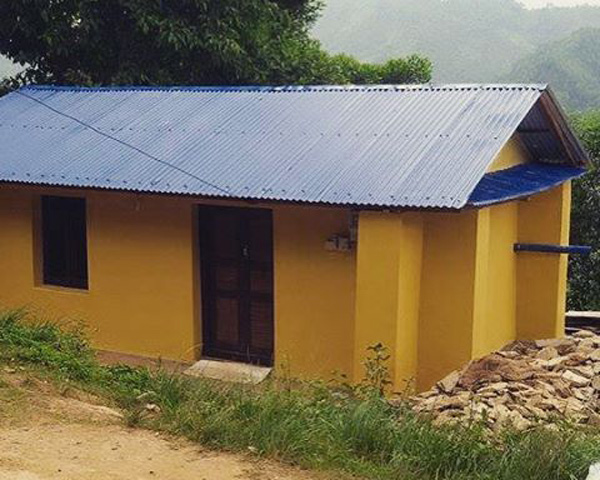
Earthbag building in Nepal is growing swiftly for numerous reasons. For one, around 55 earthbag buildings survived the earthquakes with little or no damage. That’s about the most powerful advertising you can get. People saw for themselves how earthbag buildings are stronger than the rest of the buildings in the area. In some cases almost all of the other buildings collapsed – including concrete structures – while the earthbag buildings safely withstood the quakes. This obviously made a huge impression on people and the word has spread rapidly.
Recent radio shows, blogs, websites, and social media sites such as Facebook and Meetup have further fueled interest. Hundreds of trainees are now coming to my workshops at the Osho Tapoban ashram near Kathmandu to learn how they can build this way in their villages. The training process itself has been almost dreamlike smooth. Workshop attendees understand and like earthbag building. They know it is perfect for their country. Even a large group of young engineers (who are typically very skeptical of alternative approaches) all agreed they are interested in building with earthbags. Soon there will be dozens of smart, skilled, experienced builders and trainers available to oversee earthbag construction projects.
Model homes: Numerous engineers and architects have agreed to generously donate plans to help rebuild Nepal. I’ve already received free plans for the Goldhunga after school study center that we covered in a previous post. It seems perfect as a model starter home for Nepal. Many people have toured the building and said they would like to have a home like this. The base design can be expanded to include more rooms and a second floor made with lightweight materials for food storage. Likewise, the Kamala house in the photo above built by Good Earth Nepal.org is another very good model home for Nepal. This house was built through the rainy season under tarps with good results. All free plans will be posted here shortly.
Schools and community centers: Numerous NGOs are finalizing plans to build lots of schools and other large community structures. It remains to be seen how things will actually work out, but numerous NGOs are planning dozens of earthbag projects. These community buildings will provide necessary experience and jobs for builders that will help earthbag building spread throughout the community. Unofficially, we’ve been told the Ministry of Building will likely approve these structures. Faced with the impossible task of building over half a million structures, inluding homes and schools, there really is no other practical solution. It’s virtually impossible to move large amounts of concrete and steel into remote regions with few or no roads. Earthbag building to me seems like an obvious solution. And since the government is almost powerless at enforcing building regulations in remote areas, people will most likely do whatever makes the most sense to them. And since villagers now realize the perils of building mud mortared stone buildings, earthbag building is rapidly gaining traction as the most viable alternative.
Free and low cost building information: People here tell me that our websites and videos have proven very beneficial in learning about earthbag building. You can see the list of our websites and books on the right side of this page. Also, my free YouTube videos show every step of construction.
Training centers: Key to the successfully expansion of earthbag building in Nepal is the development of training centers to teach more builders, trainers and building professionals. Several groups are currently in the process of establishing these training centers. Some plan to become international training centers that accept trainees from other countries. Stay tuned. We will report on these training centers and all other earthbag related developments here on our Natural Building Blog.
Emergency shelters: Small earthbag shelters can be built in a few days for a few hundred dollars. This is especially important with winter coming soon. Earthbag emergency shelters provide safe shelter from the elements and can be easily expanded into larger, permanent homes (transitional shelter). Building simple shelters quickly for lots of families provides lots of benefits at low cost. As you know there’s never enough money for aid relief, so it’s important to use limited funds wisely. For these reasons some NGOs are considering building large numbers of earthbag emergency shelters. One NGO today told me the other day they might build almost 150 shelters if the first few are well received by the recipients. Consider getting a local designer to help personalize the shelters for each family. See our UN Emergency Earthbag Shelter Proposal for more info.
Image source: Good Earth Nepal.org

I have friends in very rural ares of Nepal who asked me to help after the devastating earthquakes, so I recently started an NGO to help some small villages in Nepal in rebuilding their homes.I know that earth bag homes can be stabilized for seismic areas, and I know that this IS THE ANSWER. I am gathering funds and volunteers to help aid in this endeavor and i feel that your training would be the best influence in building safe, long lasting, homes for the peoples that have been made homeless by this terrible tragedy.
please check out our website for more information
we are planning a trip for may to start the rebuild.
http://www.operationrebuildnepal.com
I would really value your opinions and information if you would like to share please feel free to call me or chat me on facebook.
D. Felegie
5702258731
I just emailed you. Good Earth Nepal.org is taking over my training. They have all of my training materials that are being distributed for free.